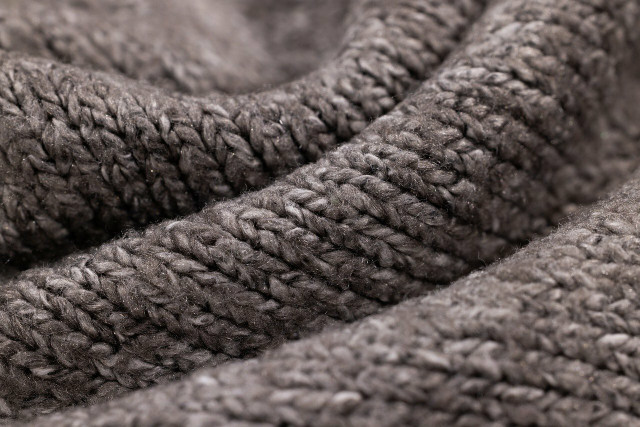Shrinking an oversized sweater is a great way to make it last. Our step-by-step guide lets you achieve that perfect fit in an easy and eco-friendly way.
Why Shrink a Sweater by Hand?

(Foto: CC0 / Pixabay / Engin_Akyurt)
Most clothing will inevitably warp and stretch out with continued use, especially thicker materials such as sweaters. Rather than dropping your winter favorites in the donation bin, you can easily shrink oversized sweaters to maintain a perfect fit for years to come.
You may be tempted to take the easy route and simply toss your sweaters in a hot machine wash-and-dry cycle, but this often does more harm than good. Friction from fabric tumbling against the walls of a washer or dryer causes fibers to warp and weaken over time; this can lead to unsightly pilling, fading, and even holes. Shrinking clothing by hand is also the more eco-friendly method since you can avoid the excessive water and energy consumption of washers and dryers. Hand-washing and -shrinking also help reduce the amount of microplastic fibers that are shed from synthetic clothing, thus lessening plastic water pollution.
Before beginning, take into consideration whether shrinking your sweater is right for you:
- Check the labels: some sweaters are sold pre-shrunk and are therefore more difficult to shrink further.
- Check the fabric: if the fibers of your sweater have become “felted” or fused together through repeated heat and wash cycles, then it will be nearly impossible to shrink.
- Check the material: different materials shrink at different rates and certain embellishments (patches, pearls, rhinestones, sequins, ruffles) may become ruined during the shrinking process.
- Wash first: If your sweater is brand new, it will often shrink significantly when you first wash it. Why your clothes shrink depends on several factors such as the materials, heat of the wash cycle, and new garments often being stretched out during manufacture. Always wash a new sweater first to avoid over-shrinking.
How to Shrink Wool, Cotton, or Synthetic Sweaters



(Foto: CC0 / Pixabay / Engin_Akyurt)
Shrinking a sweater follows many of the same steps as how to wash a wool sweater, which when done properly, can help maintain the correct fit for years. The step-by-step guide below offers an eco-friendly way to shrink wool, cotton, or synthetic fiber sweaters.
- Fill a sink or basin with enough hot water to cover your sweater. Add a few drops of gentle detergent if desired or half a cup of white vinegar to prevent color bleeding.
- Place your sweater into the hot water inside-out. Doing so will lessen friction to the outside. Let your sweater soak for up to 10 minutes, gently agitating it.
- Drain water from the sink or basin. Gently squeeze excess water from your sweater without wringing, twisting, or pulling: this may warp the fabric.
- Lay your sweater flat on a towel to absorb excess water and dry. You can roll the towel up with the sweater inside (like a burrito) or place another towel on top (like a sandwich).
- Once the sweater is moist but not soaking, iron it on high heat. Make sure to place a towel or other cloth on top of your sweater to avoid direct heat damage. This method is great for focusing on sleeves or collars without shrinking the entire garment.
- Leave your sweater flat to fully dry. Avoid leaving it near heat sources as this may cause excess shrinkage.
Some considerations regarding materials:
- Wool and other animal fibers can shrink significantly under heat and are also more prone to felting. In this case, reduce the heat used in the first soak and avoid the ironing method entirely; this is also the more eco-friendly option as it uses less energy. It’s better to be gentle first than to over-shrink; you can always repeat with higher heat if your sweater is still too large.
- Cotton is less reactive to heat than wool, so you may need to use higher temperatures or iron for longer.
- Synthetics such as polyester or acrylic are difficult, but not impossible to shrink. Because these fabrics are derived from plastic, you will need to use higher heat or several treatments to shrink your sweater while taking care not to melt the fiber. Blends of natural and synthetic fibers will shrink much more easily with less heat.
Stretching Out Sweaters after Over-Shrinking



(Foto: CC0 / Pixabay / Pexels)
Shrinking clothing isn’t an exact science, so the possibility exists that your sweater may become too small. While stretching is never guaranteed to be 100 percent successful, the process is simple and eco-friendly. Check out our guide on how to unshrink your clothes for more details.
Follow the above steps 1-4 for shrinking a sweater, but this time use cold or lukewarm water with a small amount of fabric softener and soak for 10-20 minutes. This will relax the fibers and make them easier to stretch. Dry as directed in steps above until your sweater is moist, but not soaking.
Once excess water is removed, there are a few different strategies you can follow:
- Use your hands to gently stretch out the fabric in the desired areas.
- Roll up towels and stuff them inside of your sweater to stretch the fibers in all directions.
- If you want to be more exact, you can use pins to stretch out your sweater. Place your moist sweater and towel onto a flat porous surface (cork or foam). Stick pins through the edges of your sweater and into the board so that the fabric is being gently stretched in all directions.
In each of these cases, you should lay your sweater flat on a towel to dry.
Read on:
- Hand Washing Clothes: Tips and Tricks
- Drying Laundry Naturally: An Alternative to Your Dryer
- How to Wash Bras and Underwear: Tips for Germ-Free Laundry
Do you like this post?






